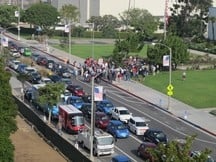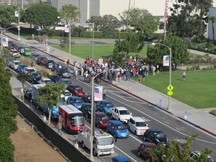
Last Sunday was witness to a unique parade on Main Street that may wind up in the Guinness Book of World Records. The event might have represented the largest assemblage in world history of freeway capable electric cars (188) on a public road at any one time. (Parade organizers have filed with Guinness.)
Because EVs are virtually noiseless, it was also perhaps the quietest parade in world history. Or, as one onlooker suggested, “It was so quiet it was like a funeral procession for the oil industry!” (I only wish.)
If you missed the parade, it’s on YouTube. Just type “National Plug in Day 2011” and after viewing that, type “Electric Car Parade on Main Street.” (It’s the third video on that page.)
Paul Scott, one of the parade organizers and co-founder of Plug in America, is also a Santa Monica resident. Paul points out that “in 30 years our roads and highways will be so quiet that the loudest noise coming from an EV might be the windshield wiper.”
I just hope 30 years from now there’s still breathable air left and that global warming hasn’t moved Santa Monica to Phoenix. (I realize that some believe climate change is a liberal myth but, then again, some believe Elvis is still alive.)
The truth is, the thought of a world without noisy, noxious, toxin-spewing vehicles sounds very hopeful. I’m old enough to remember Los Angeles before smog. (Or at least before it looked like a brown cloud on the horizon.)
In the second grade I remember our first “smog alerts.” We kids weren’t allowed to play outside because our eyes would burn and we couldn’t take a deep breath without coughing. Personally I found it like a bad horror movie that the air was so “toxic,” even though I didn’t know what the word toxic meant.
Many Angelenos don’t realize that we had rapid transit more than a hundred years ago. It started in 1901 with the Los Angeles Electric Railway, which at its height had 20 lines and 1,250 trolleys running through the core of L.A., Echo Park, Westlake, Hancock Park, Exposition Park, West Adams, Crenshaw, Vernon and Boyle and Lincoln heights. (Whew.)
Demographic shifts, the emergence of the automobile and increased traffic on city streets helped kill the street car. There are also theories that General Motors and a number of other companies purchased streetcars with the sole purpose of dismantling them and replacing them with bus services.
And then, in the name of progress, came our lovely freeway system, which we were told represented a futuristic nirvana of automobile travel. Instead it turned into bumper-to-bumper log jams and smog so thick you could cut it with a chainsaw.
In case you hadn’t noticed, I’m not a big fan of oil and the oil industry. Not only has oil helped pollute our air, pursuit of oil via endless wars has drained our national treasury and costs hundreds of thousands of innocent lives. (On the bright side for some, oil companies are showing record profits.)
I live on Neilson Way, which is a mini-freeway. It’s constantly noisy and the apartment windows facing the street are covered with black soot. (If that’s what it does to windows, imagine what it’s doing to our lungs.)
Fortunately, the parade of silent and stylish electric vehicles this past Sunday gave me hope for the future. One day we’ll live in a world without tailpipes. I don’t know how we’ll get along without the noise and pollution of internal combustion, but we’ll just have to manage.
To find out more about EVs go to www.pluginamerica.org and click on the “vehicles” tab. Also check out Paul Scott’s profound YouTube video by typing, “Sustainable Living Lec 7” and clicking on the second video.
When he isn’t busy lamenting the passing of Col. Gaddafi, Jack can be reached Jnsmdp@aol.com.









